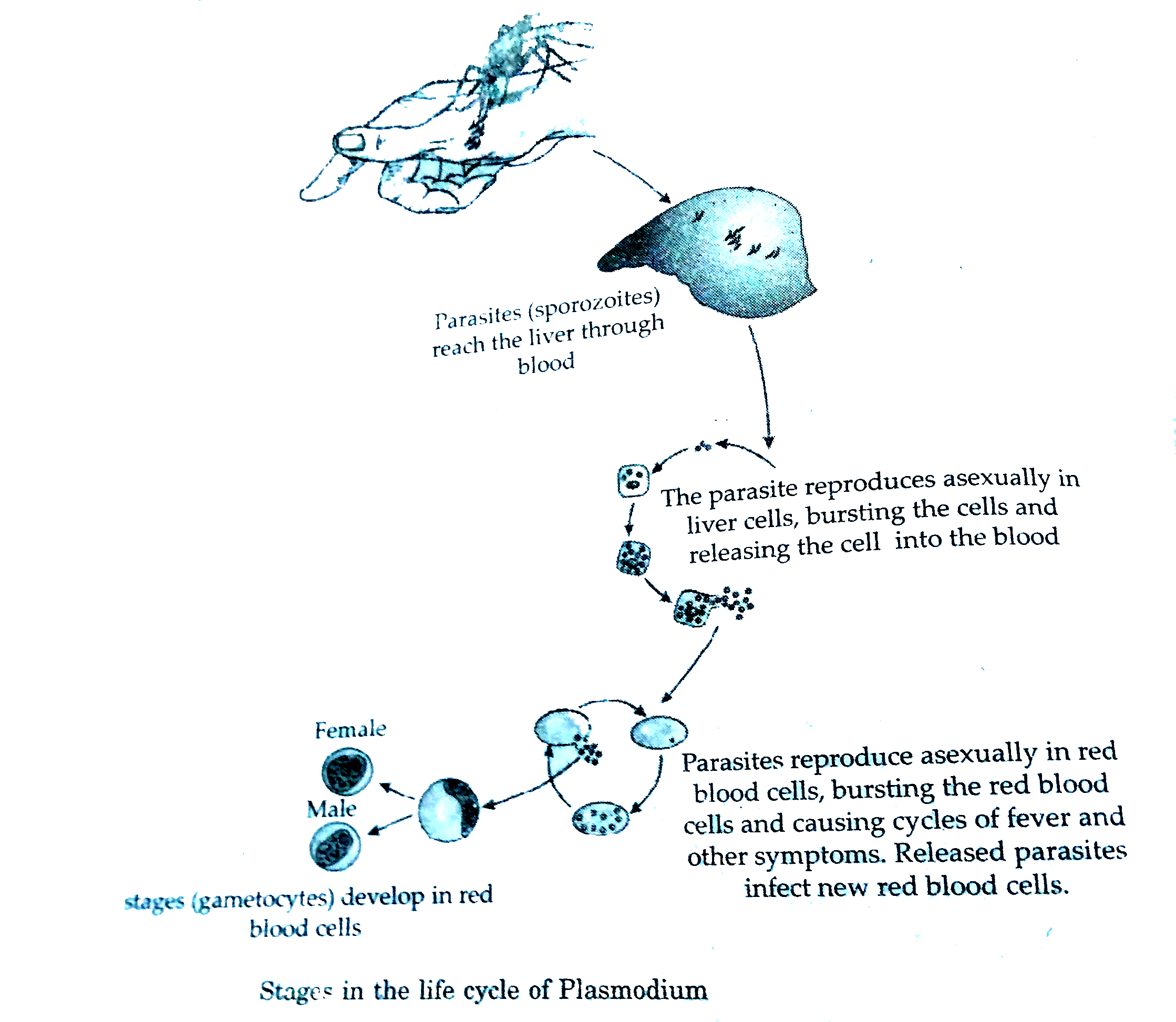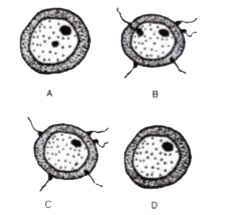(i) How and at what stage does Plasmodium enter into a human body ?
(ii) With the help of a flow-chart only show the stages of asexual reproduction in the life-cycle of the parasite in the infected human.
(iii) Why does the victim show symptoms of high fever ?
(i) Plasmodium enters the human body as sporozoites that are stored in the salivary glands of the female anopheles mosquito. When the mosquito bites a human, the sporozoites are introduced into his/her body.
(ii) 
(iii) The victim shows symptoms ofhigh fever due to the release of a toxic substance, haemozoin from the ruptured RBCS that have been infected by the sporozoites.
Similar Questions
Show with the help of a flow chart only, the life cycle of malarial parasite in humans.
View Solution(i) Which organ of the human body is initially affected when bitten by an infected female Anopheles ? Name the stage of the parasite that infects this organ.
(ii)Explain the events that are responsible for chill and high fever in the patient.
View Solution
Knowledge Check
Study carefully the following stages of life cycle of malarial parasite i.e., Plasmodium. Arrange these stages in the correct sequence and select the correct answer.
1. Sporozoites leave the blood stream and enter the liver cells of man.
2. Sporozoites present in the salivary glands of female Anopheles mosquito are injected into the blood stream of man.
3. The parasite reproduces asexually in RBCs, resulting in bursting of RBCs and causing the cycles of fever, relased parasites infect new RBCs.
4. The parasite reproduces asexually in liver cells, ultimately causing the rupturing of cells.
5. Two types of gametocytes i.e., microgametocytes and macrogametocytes develop in the RBCs.
6. Female Anopheleles mosquito takes up the gametocytes with blood meal of an infected person.
7. Mature infective stage of the parasite i.e., sporozoites escape from intestine and migrate to the mosquito's salivary glands.
8. Fertilisation and developmental stages of the parasite take place in mosquito's stomach.A(a) 2→1→4→3→5→6→8→7B(b) 2→4→1→3→5→6→7→8C(c) 1→2→4→3→5→6→8→7D(d) 6→8→7→4→5→2→3→1
(a) Name the infective stage of Plasmodium which Anopheles mosquite take in along with the blood meal from an infected human.
(b) Why does the infection cause fever in human ?
Give a flow chart of the part of the life-cycle of this parasite passed in the insect.
View Solution(a) Name the infective stage of Plasmodium which Anopheles mosquite take in along with the blood meal from an infected humen.
(b) Why does the infection cause fever in humen ?
Give a flow chart of the part of the life-cycle of this parasite passed in the insect.
View SolutionGive the scientific name of the parasite that causes malignant malaria in humans. At what stage does this parasite enter the human body? Trace its life cycle in human body.
View Solution(i) How many primary follicles are left in each ovary in a human female at puberty ?
(ii) Draw a sectional view of the ovary showing the different follicular stages of a human female in her preovulatory phase of menstrual cycle.
View SolutionGiven below is a diagram of the reproductive system of a human female :

(i) Name the parts numbered 1-6.
(ii) Normally after how many days does an ovary release an egg?
(iii) Where are the sperms released during coitus?
(iv) What do the sperms do after being released ?
(V) What is the function of the organ numbered 5 ?
(vi) How many days does it normally take from the fertilisation of the egg up to the birth of the baby?
View Solution(a) State what happens in the human body when malarial parasites infected RBCs burst to release the parasites in the blood.
(b) Mention the specific sites in the host body where production of
(i) sporozoites and (ii) gametocytes take place in the life cycle of the malarial parasites.
View SolutionGiven below are diagrams showing the different stages in the process of fertilisation of an egg in the human female reproductive tract.
Study the diagrams and answer the questions

(i) Arrange the letters given below each diagram in a logical sequence to show the correct order in the process of fertilisation.
(ii) Where does fertilisation normally take place? What is 'Implantation' that follows fertilisation ?
(iii) Mention the chromosome number of the egg and zygote in humans.
(iv) Explain the term 'Gestation'. How long does Gestation last in humans ?
(v) Draw a neat, labelled diagram of a mature human sperm.
View Solution
